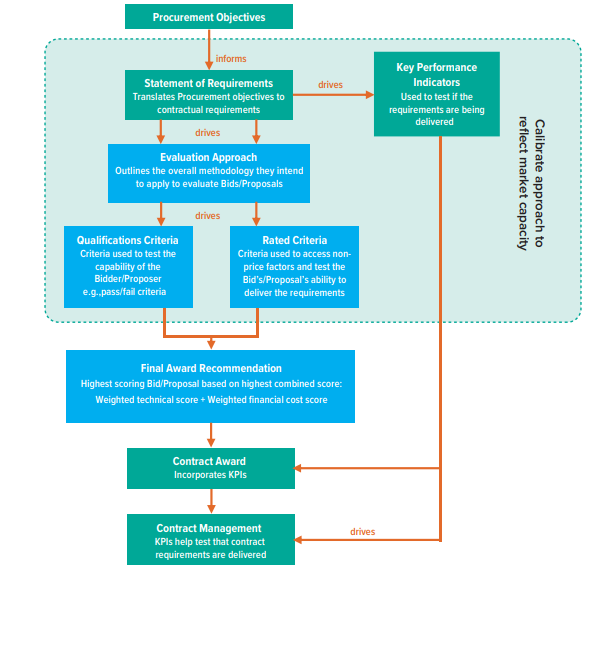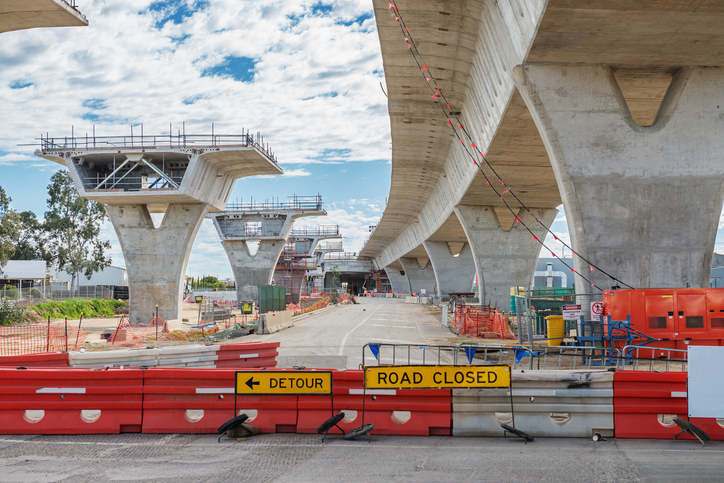Securing a win in public sector construction bidding is as complex as it is crucial. While many assume that the lowest bid always wins, trends reveal a more nuanced landscape where strategic insight and systematic approaches separate the serial winners from the rest.
Debunking the lowest bid myth
The common misconception that the lowest bid always wins is becoming outdated. Modern bid evaluation processes – from the World Bank guidelines on evaluating bids and proposals, to Crown Commercial UK and even the Victorian Government in Australia – consider a multitude of factors beyond price, reflecting a shift towards value-based decision-making.

World Bank evaluation approach (similarly adopted by other procurement departments
Key factors in modern bid evaluation
Recent research by Beshah et al. (2024) has identified five key pillars of project success criteria:
- Efficiency
- Effectiveness
- Sustainability
- Environmental impact
- Satisfaction
These pillars encompass a broader range of indicators, including quality, cost, time, health and safety, environmental impact, stakeholder satisfaction, and lessons learned which is consistent with what we are now seeing in procurement evaluation, namely:
- Value for money: Evaluators have moved beyond the ”iron triangle” (time, cost, quality) to balancing cost with other non-price criteria that consider quality, risk management, and project complexity. There’s also a growing emphasis on Environmental, Social & Governance (ESG) factors as a way to assess the credibility and effectiveness of bidders’ methodologies. Multi-factor criteria (price and non-price) will continue to evolve.
- Enhanced scrutiny: Extremely low bids face increased scrutiny for feasibility and sustainability. While winning a bid is the goal, it’s crucial to understand the concept of the “winner’s curse.” This phenomenon occurs when the winning bid is too low to cover the true value of the project. The winner’s curse is especially pertinent in construction bidding, where project costs and complexities can be difficult to accurately estimate. Winning bidders may find themselves committed to projects that are less profitable or more challenging than initially anticipated. Expect to see more risk-oriented questions in your tenders.
- Non-linear relationship: The connection between bid price and win probability isn’t straightforward. Higher-priced bids can still remain competitive when offering superior technical proposals or innovative approaches, especially where they can support the delivery of KPIs and other measures to advance broader policy outcomes and stakeholder satisfication.
From reactive to proactive
The construction sector has witnessed a surge in insolvencies, with a large number of companies going into liquidation in the past financial year alone. This alarming trend has highlighted the need for a more comprehensive approach to procurement that addresses potential risks and challenges upfront.
Frontloading risk assessment
Modern procurement practices are now being “frontloaded” with more rigorous risk assessment and mitigation strategies. This shift aims to reduce the likelihood of contract failure and project issues by identifying and addressing potential problems before they escalate. The increasing popularity of Early Contractor Involvement (ECI) brings contractors into the project planning process earlier, and while ECI may extend the initial project timeline, it can ultimately compress the overall duration by reducing pre-contract clarifications, minimising rework, and allowing for overlapping activities
Strategic tools for competitiveness
To navigate the increasingly complex bidding process, high performing companies are turning to advanced tools and strategies:
- Centralised bid management: Platforms like Bidhive offer an integrated view of the entire end-to-end bidding process to link every part of the process together – from the initial pre-contracts opportunity through to the post-bid feedback and contract milestones. The benefit of having information all in one place is that you can track customer bidding history, pricing information (need a margin calculator? We have that too!) and even resources who worked on each bid. The ability to view an audit trail of inputs is very helpful given bid submissions don’t have ”authored by John and Joanne” on them!
- Advanced analytics: Tools such as Bidhive provide not only insights of won/lost bids, but also insights into financial metrics and lessons learned, helping to identify strengths and areas for improvement. Leveraging this continuous improvement cycle can reduce gaps between what is known, and not yet known to demonstrate a more mature risk management and iterative learning approach.
- Knowledge libraries and data sharing: Centralised information prevent silos and the burden of reinventing the wheel each time. This improves collaboration, especially with growing multi-factor criteria demands requiring cross-functional input. Bidhive supports not only content library creation for your bid team, but captures data right across the bid lifecycle, including your competitors and the load capacity and tasks assigned to your bid team members. Importantly, this data can be easily turned into reports.
- AI-powered assistance: Utilising AI for content creation and research ensures relevant, timely proposals that meet evolving client demands. It can help you analyse the tender package; search for previous responses or past methodologies; create a risk matrix or review your final drafts – this also frees up your teams to focus on the more bespoke parts of the tender.
Conclusion
Success in public sector construction bidding goes beyond offering the lowest price. It requires a nuanced understanding of evaluation processes, strategic alignment with client expectations, effective risk management, and leveraging of tools to support the bidding process. By adopting a holistic and systematic approach that considers these factors, bidders can enhance their success rates while avoiding the pitfalls of the winner’s curse. As the construction and infrastructure sectors continue to evolve, so too must bidding strategies. The key lies in balancing competitiveness with realistic, sustainable proposals that offer genuine value.
Request a demo today to learn more about how Bidhive streamlines bid and response management. You can also read more blog articles for practical advice on running a successful bidding function.


